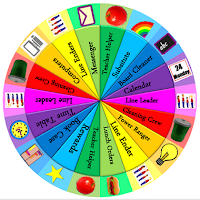Timetable
A displayed timetable is great to have in the room for a variety of reasons and I happen to have three on display in my classroom!
The first timetable I have is the standard timetable that we try to follow each week (when there aren't interruptions). It is displayed on my door so parents and students can discuss what we are doing that day before they are allowed in. I also send copies home to parents at the beginning of they year and as requested through out the year as I change my timetable around regularly.
The second timetable is my weekly lesson planning document. I choose to type mine up rather then have a Teacher Journal/Planner/DWP as I find this simpler to use (copy and paste is my key to quick planning). I also try hard to keep it to one page. It is pinned up next to my mat area for easy access so I don't miss anything out and can give the students a run through of the day at the start of the day.
Lastly, I have the class timetable that is changeable depending on the day and lessons plans for that day. I have a student responsible for changing it daily and they use the headings from my timetable to change it.
You can purchase a copy of it here:http://www.teacherspayteachers.com/Product/Day-to-Day-Changeable-Timetable-836908
I have had a child with Autism in my class every single year and they say that what is best for students with Autism is best practice for all students. A timetable helps to settle students as they know what they are doing and what they are going to do. It helps to reduce anxiety and keep the students focused. I like it as it stops the "what are we doing now/next?" question or the just as popular "when are we doing...?". Think about when you have a PD day, don't you like knowing what you are doing? We don't like surprises and we like to keep a track of what we are up to in the day.
Usually students with disabilities have their own timetable (on their desk or near by wall). I try to ease them into a class timetable so they don't feel different and can learn greater independence. Not to mention the work that goes into doing their timetable daily and the extra clutter it creates on their desk. Of course there are some students that need their own timetable, especially if they do a great amount of separate work or need the action of 'taking off' things they have done.
The pictures on my timetable are simple so that students who cannot read can still use it. It is quick to update and takes up a small amount of room. If you are one of the teachers that don't put up a timetable or painstakingly write it up on the board, consider using this timetable.













